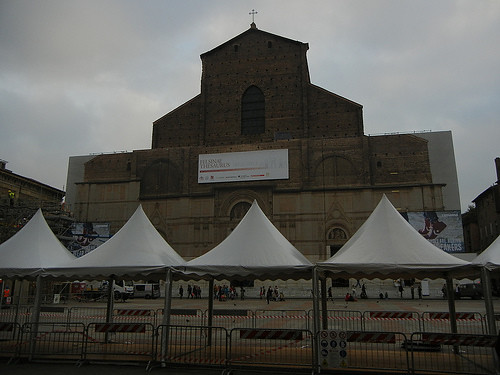Near the end of our 2012 Austria and Italy trip, we stayed in Bologna for three nights, near Piazza Maggiore, therefore I was able to admire the impressive structure several times a day. When we were in Bologna, this Basilica's front façade was covered due to renovation or repair after an earthquake shook Italy in May that year; however, we were able to have a facsimile of the façade, due to full-scale reproduced images printed on huge screens or curtains hanging in front of the church.






The dominant characteristics of this church was its symmetrical feature of the front and its rough-hewed sheer massiveness. Proud, solid, and without vanity.



The Palazzo D'Accursio (Palazzo Comunale) by Piazza Maggiore and the adjacent Fontana del Nettuno provided wonderful vantage points and backdrops for this massive church:

Basilica di San Petronio (right) and Sanctuary of Santa Maria della Vita (domed building) viewed from Palazzo D'Accursio (Palazzo Comunale)

Palazzo D'Accursio (Palazzo Comunale) and Basilica di San Petronio

Fontana del Nettuno, Piazza del Nettuno, and Basilica di San Petronio
However, in order to fully gauge the massiveness of this structure, it would be the best to approach it from the back where other "modern" buildings helped viewers to scale the Basilica. Moreover, some exposed bricks lent a feeling of a rugged fortress.

Basilica di San Petronio, Bologna



But this Basilica was not just muscular strength. At the foot of the building, one could admire the elegantly proportioned and decorated arched loggia. It was simply beautiful.

By the time we were leaving Italy, huge scaffolding sprouted up overnight in front of Basilica di San Petronio, and it was apparently that a large event was being planned. Definitely this spot was the beating heart of this pulsating city.

~~~~~~~~~~~~
Basilica San Domenico was another major church in Bologna, with its significance as the burial church of Saint Dominic, founder of the Order of Preachers (Dominicans), whose remains were buries inside the "exquisite shrine Arca di San Domenico, made by Nicola Pisano and his workshop, Arnolfo di Cambio and with later additions by Niccolò dell'Arca and the young Michelangelo." [source: wikipedia]
At the entrance to the compound, a sculpture of St. Dominic on tall pedestal greeted people; with his outstretched arms, his compassion was palpable.



The interior of the Basilica was at once spare and sumptuous, with the typical Italian Renaissance muted color scheme and pleasing proportion in general but became more ornate and even in the Baroque style around the shrine for St. Dominic.








Arca di San Domenico (lower left)

One of the coolest features of this Basilica was the carved wooden chairs in the choir, each of them featured a scene from the Bible.

The paintings below continued more flamboyant coloration and compositions and even the monochromatic relief were more florid and less austere. Such juxtaposition of styles did not create chaos; rather they created variations and drama.




Finally it was the same comforting St. Dominic who bid visitors farewell and concluded the visit with the right chord.

Related posts on Art · 文化 · Kunst:
- Basilica Santuario Santo Stefano, Bologna- Il palazzo dell'Archiginnasio, Bologna
- Palazzo D'Accursio (Palazzo Comunale), Bologna - Bologna Wrap Up
- Cappella degli Scrovegni and Musei Civici degli Eremitani in Padova (Padua)
- Visiting Four Universities in Austria and Italy
- San Giorgio Maggiore, Il Redentore, Scuola e Chise Grande di San Rocco, Venezia
- Magical Piazza San Marco in Venice
- Magnificent Churches in Vienna
Label: Italy, Austria and Italy Trip 2012





No comments:
Post a Comment